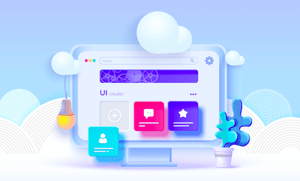As we enter the age of low-code and no-code, it's become ever more common for new sites to pop up from building tools like Bubble, Carrd, Webflow, and other “skinny-site” options. No-code building assets like these have drastically altered the digital landscape and opened up the building process to many more people who *didn't* study Python or Java in school. They also raise awareness, however, of another potential gap in education and skillset worth acknowledging: UI/UX design.
A few years ago, I hit a nerve – thousands, actually – with my (somewhat reactionary) piece: Stop Telling Me I Need to Code. Even before the no-code movement really found its steam and traction, it was clear that many people were frustrated by wanting to build, but effectively being told that they needed to be engineers in order to do so. They – we – felt that fitting into a box of learning to code was the only real way forward. Low and no-code tools succeed because they level the playing field and enable those on the outside to find doors in.
UI/UX appears to offer a similar accessibility challenge as the coding obstacle for those of us who want to create, but don’t wish to become professional engineers. The aforementioned gap in UI/UX understanding – not merely rectified with simple templates – is another area where a great equalizing movement is necessary. Perhaps the current dialogue that we’re having around low-code and no-code options might also apply to UI/UX.

UI/UX is a black box for many business owners who don't spend a ton of time on tech-Twitter or Product Hunt. It can even be overwhelming to those with a solid foundation in UI/UX. But if websites can be built without software engineers, might it also be possible to create effective user experiences without needing to become a UI/UX expert?
Consider this: Your website is the house you're trying to build, and the low-code and no-code tools out there are wonderful guides to laying the core infrastructure. You're using Carrd for the electricity and plumbing, or Webflow and Bubble to lay the bricks and caulk up the cracks. These tools succeed because they quickly put each of us one tremendous step further to having a working site we’re happy (enough) with. In doing so, part of what they ostensibly do is remove the friction of feeling overwhelmed when getting a new site off the ground. Don’t know how to write the nuts & bolts code? No problem, here’s Carrd, it simplifies everything.
Yet as useful as these tools are, there is still a gap in understanding how to make the house look nice on the inside. Sure, they have templates to choose from, but little in the form of strategy or guidance on how to approach design (or why to approach it that way). That same overwhelmed feeling exists for a lot of people when trying to understand why certain templates or design decisions are better than others. It still causes an anxiety-like friction that could otherwise be neutralized with better understandings of “how” and “why.”
Related: The Pros and Cons of No-Code Platforms
GET A FREE COPY OF 'HOW TO TACKLE A WEBSITE REDESIGN' EBOOK
%20(1)%20(1)%20(1)%20(1)%20(1).png?width=579&height=411&name=website%20redesign%20resource%20image%20(4)%20(1)%20(1)%20(1)%20(1)%20(1).png)
As with the no-code movement, this doesn’t (and shouldn’t) be extrapolated out to “replacing all UI/UX designers” with automated tools or solutions. Even in the no-code landscape, engineers aren’t finding themselves replaced. They are simply able to solve different problems now that tools like Webflow and Bubble have made it easy for non-tech people to construct the basics themselves. The same would be true if we had similar UI/UX solutions; designers and UI/UX professionals would be able to divert their attention to more complex (and likely interesting) challenges.
Reach us at info@sfappworks.com to discuss your new website.
In embracing low and no-code, we allowed ourselves as an industry and community to open up to creators who communicate and build differently than engineers. The same would again be possible with a greater democratization of “skinny” UI/UX tools and understanding. It would open up another hatch in business and tech and allow creators of different disciplines and skill-levels to better equip themselves and their sites. It would allow those already utilizing no-code solutions to further understand how to make their own sites more robust with good user experiences. In doing so, it might similarly provide greater understanding to those professionals who are within the black box of UI/UX and enable them to progress in their own growth.

I imagine a set of “skinny” tools – perhaps compatible with the no-code options already available – that explain why certain UI/UX designs or layouts are ideal. Perhaps ones that would even make real-time suggestions as I’m designing my site. The possibilities are almost endless when we consider more ways to level the creation playing field. If the response to my coding article was any indication, there might be countless creators out there simply looking for a door inside to better understand and start building.
Related: No-Code Development Services
DOWNLOAD A GUIDE TO CHOOSE THE RIGHT NO-CODE DEVELOPMENT PLATFORM.
.png?width=479&name=no-code%20platform%20pdf%20(17).png)


COMMENTS